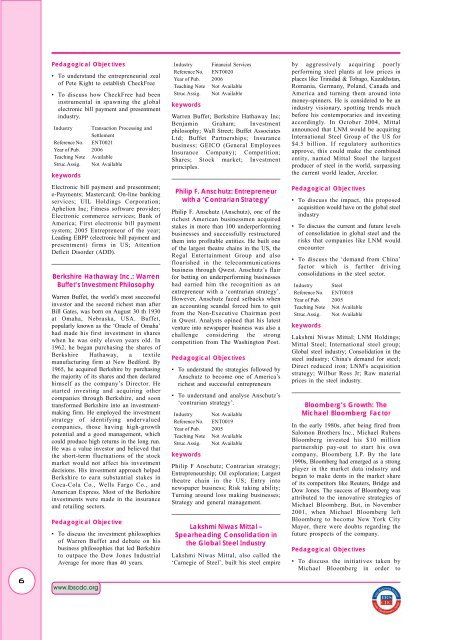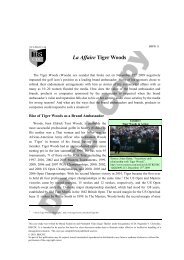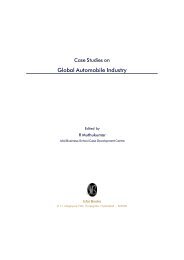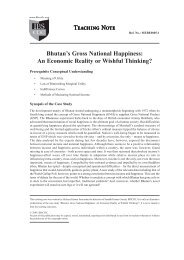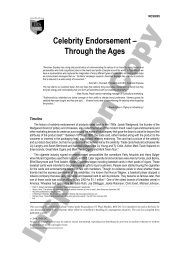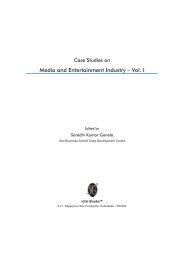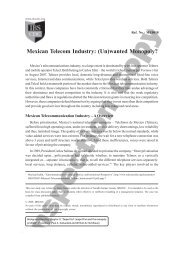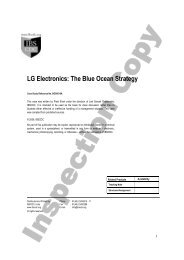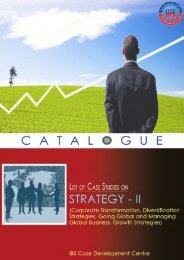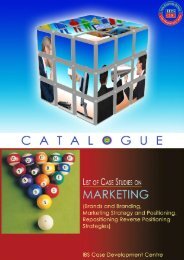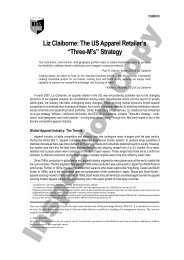Entrepreneurship Case Studies Catalogue
Entrepreneurship Case Studies Catalogue
Entrepreneurship Case Studies Catalogue
You also want an ePaper? Increase the reach of your titles
YUMPU automatically turns print PDFs into web optimized ePapers that Google loves.
6<br />
Pedagogical Objectives<br />
• To understand the entrepreneurial zeal<br />
of Pete Kight to establish CheckFree<br />
• To discuss how CheckFree had been<br />
instrumental in spawning the global<br />
electronic bill payment and presentment<br />
industry.<br />
Industry Transaction Processing and<br />
Settlement<br />
Reference No. ENT0021<br />
Year of Pub. 2006<br />
Teaching Note Available<br />
Struc.Assig. Not Available<br />
keywords<br />
Electronic bill payment and presentment;<br />
e-Payments; Mastercard; On-line banking<br />
services; UIL Holdings Corporation;<br />
Aphelion Inc; Fitness software provider;<br />
Electronic commerce services; Bank of<br />
America; First electronic bill payment<br />
system; 2005 Entrepreneur of the year;<br />
Leading EBPP (electronic bill payment and<br />
presentment) firms in US; Attention<br />
Deficit Disorder (ADD).<br />
Berkshire Hathaway Inc.: Warren<br />
Buffet’s Investment Philosophy<br />
Warren Buffet, the world’s most successful<br />
investor and the second richest man after<br />
Bill Gates, was born on August 30 th 1930<br />
at Omaha, Nebraska, USA. Buffet,<br />
popularly known as the ‘Oracle of Omaha’<br />
had made his first investment in shares<br />
when he was only eleven years old. In<br />
1962, he began purchasing the shares of<br />
Berkshire Hathaway, a textile<br />
manufacturing firm at New Bedford. By<br />
1965, he acquired Berkshire by purchasing<br />
the majority of its shares and then declared<br />
himself as the company’s Director. He<br />
started investing and acquiring other<br />
companies through Berkshire, and soon<br />
transformed Berkshire into an investmentmaking<br />
firm. He employed the investment<br />
strategy of identifying undervalued<br />
companies, those having high-growth<br />
potential and a good management, which<br />
could produce high returns in the long run.<br />
He was a value investor and believed that<br />
the short-term fluctuations of the stock<br />
market would not affect his investment<br />
decisions. His investment approach helped<br />
Berkshire to earn substantial stakes in<br />
Coca-Cola Co., Wells Fargo Co., and<br />
American Express. Most of the Berkshire<br />
investments were made in the insurance<br />
and retailing sectors.<br />
Pedagogical Objective<br />
• To discuss the investment philosophies<br />
of Warren Buffet and debate on his<br />
business philosophies that led Berkshire<br />
to outpace the Dow Jones Industrial<br />
Average for more than 40 years.<br />
www.ibscdc.org<br />
Industry Financial Services<br />
Reference No. ENT0020<br />
Year of Pub. 2006<br />
Teaching Note Not Available<br />
Struc.Assig. Not Available<br />
keywords<br />
Warren Buffet; Berkshire Hathaway Inc;<br />
Benjamin Graham; Investment<br />
philosophy; Wall Street; Buffet Associates<br />
Ltd; Buffet Partnerships; Insurance<br />
business; GEICO (General Employees<br />
Insurance Company); Competition;<br />
Shares;<br />
principles.<br />
Stock market; Investment<br />
Philip F. Anschutz: Entrepreneur<br />
with a ‘Contrarian Strategy’<br />
Philip F. Anschutz (Anschutz), one of the<br />
richest American businessmen acquired<br />
stakes in more than 100 underperforming<br />
businesses and successfully restructured<br />
them into profitable entities. He built one<br />
of the largest theatre chains in the US, the<br />
Regal Entertainment Group and also<br />
flourished in the telecommunications<br />
business through Qwest. Anschutz’s flair<br />
for betting on underperforming businesses<br />
had earned him the recognition as an<br />
entrepreneur with a ‘contrarian strategy’.<br />
However, Anschutz faced setbacks when<br />
an accounting scandal forced him to quit<br />
from the Non-Executive Chairman post<br />
in Qwest. Analysts opined that his latest<br />
venture into newspaper business was also a<br />
challenge considering the strong<br />
competition from The Washington Post.<br />
Pedagogical Objectives<br />
• To understand the strategies followed by<br />
Anschutz to become one of America’s<br />
richest and successful entrepreneurs<br />
• To understand and analyse Anschutz’s<br />
‘contrarian strategy’.<br />
Industry Not Available<br />
Reference No. ENT0019<br />
Year of Pub. 2005<br />
Teaching Note Not Available<br />
Struc.Assig. Not Available<br />
keywords<br />
Philip F Anschutz; Contrarian strategy;<br />
<strong>Entrepreneurship</strong>; Oil exploration; Largest<br />
theatre chain in the US; Entry into<br />
newspaper business; Risk taking ability;<br />
Turning around loss making businesses;<br />
Strategy and general management.<br />
Lakshmi Niwas Mittal –<br />
Spearheading Consolidation in<br />
the Global Steel Industry<br />
Lakshmi Niwas Mittal, also called the<br />
‘Carnegie of Steel’, built his steel empire<br />
by aggressively acquiring poorly<br />
performing steel plants at low prices in<br />
places like Trinidad & Tobago, Kazakhstan,<br />
Romania, Germany, Poland, Canada and<br />
America and turning them around into<br />
money-spinners. He is considered to be an<br />
industry visionary, spotting trends much<br />
before his contemporaries and investing<br />
accordingly. In October 2004, Mittal<br />
announced that LNM would be acquiring<br />
International Steel Group of the US for<br />
$4.5 billion. If regulatory authorities<br />
approve, this could make the combined<br />
entity, named Mittal Steel the largest<br />
producer of steel in the world, surpassing<br />
the current world leader, Arcelor.<br />
Pedagogical Objectives<br />
• To discuss the impact, this proposed<br />
acquisition would have on the global steel<br />
industry<br />
• To discuss the current and future levels<br />
of consolidation in global steel and the<br />
risks that companies like LNM would<br />
encounter<br />
• To discuss the ‘demand from China’<br />
factor which is further driving<br />
consolidations in the steel sector.<br />
Industry Steel<br />
Reference No. ENT0018<br />
Year of Pub. 2005<br />
Teaching Note Not Available<br />
Struc.Assig. Not Available<br />
keywords<br />
Lakshmi Niwas Mittal; LNM Holdings;<br />
Mittal Steel; International steel group;<br />
Global steel industry; Consolidation in the<br />
steel industry; China's demand for steel;<br />
Direct reduced iron; LNM's acquisition<br />
strategy; Wilbur Ross Jr; Raw material<br />
prices in the steel industry.<br />
Bloomberg’s Growth: The<br />
Michael Bloomberg Factor<br />
In the early 1980s, after being fired from<br />
Salomon Brothers Inc., Michael Rubens<br />
Bloomberg invested his $10 million<br />
partnership pay-out to start his own<br />
company, Bloomberg LP. By the late<br />
1990s, Bloomberg had emerged as a strong<br />
player in the market data industry and<br />
began to make dents in the market share<br />
of its competitors like Reuters, Bridge and<br />
Dow Jones. The success of Bloomberg was<br />
attributed to the innovative strategies of<br />
Michael Bloomberg. But, in November<br />
2001, when Michael Bloomberg left<br />
Bloomberg to become New York City<br />
Mayor, there were doubts regarding the<br />
future prospects of the company.<br />
Pedagogical Objectives<br />
• To discuss the initiatives taken by<br />
Michael Bloomberg in order to


